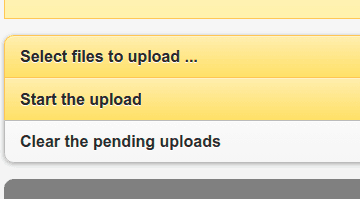TLDR:
If you didn't get your TSL certificate file execute Generate local TSL first.
git clone https://github.com/zhiva-ai/pacs-server.git
docker-compose upRequirements
Before we start please make sure your server has access to:
- Unix-base shell
- Docker
- Docker Compose
- OpenSSL
Get the server code
You can either clone this repo
git clone https://github.com/zhiva-ai/pacs-server.gitor download it directly from ZhivaAI PACS server.
Generate local TSL certificate
(only once every 365 days)
If you already have the
.crtand.keyfiles do not generate them again. Go straight to Build the server section and run your server with existing certificate.
Before we starty storing data on the server we have to secure the connection between the server and the viewer. We're going to use Transport Layer Security (TSL). First, we have to generate certificate (.crt) and key (.key) files. Because we're doing it from the local server we're going to use OpenSSL (we don't need external party to sign certificate, if you want to use it on the external server you should sign with something like Let's Encrypt).
To generate local certifiate please execute following command in the terminal window (make sure openssl is installed).
openssl req -x509 \
-nodes -days 365 \
-newkey rsa:2048 \
-keyout zhiva.key \
-out zhiva.crt \
-subj "/C=PL/L=Wroclaw/O=Your Company, Inc./CN=localhost"Change -subj to describe your organization:
C- country code (2 letter code)L- location (city name)O- organization nameCN- full domain name (uselocalhostfor local servers)
Then copy .crt file as trusted certificate:
cat zhiva.crt > trusted.crtSetup your local server
At this point you should have 2 .crt files and 1 .key file. Check this by calling
ls *.{crt,key}from your main directory. It should return following result trusted.crt zhiva.crt zhiva.key.
If one of those files is missing go back to Generate local TSL certificate section and make sure you have all of them.
Build the server
docker-compose upAfter starting the server you should be able to access localhost/zhiva/app/explorer.html#upload where you can upload your files.
You might be prompted with the message about invalid SSL certificate. This is caused by using OpenSSL to generate certificate for
localhostand that certificate has no 3rd party that confirms its authenticity. It's fine for local network but remember to use proper certificate if the server is accessible from outside your network.
Access from within internal network
If you have more than one computer inside your network (or VPN connection), then you can share the server settings with them. To check the server address please run the following command:
Linux or Mac:
ifconfigWindows
ipconfigand look for the setting with the inet value that starts with 192.168.. That should by your address in the local network. You should be able to access the upload page from https://192.168.x.x/zhiva/app/explorer.html.
Upload your DICOMs
Go to localhost/zhiva/app/explorer.html#upload and click on Select files to upload.
After selecting all the DICOMs click Start the upload to store them on the server.
All DICOMs are stored in Docker's persistent volume so even after restarting the server all your files are still accessible.
Now you should be able to access studies which were generated after uploading DICOM files. List of studies is available at https://localhost/zhiva/app/explorer.html#find-studies.
FAQs
- "How to use this server with your DICOM viewer?"
Detailed instruction is described in Managing servers inside the DICOM viewer guide.
- "Why my server doesn't accept very large DICOM files?"
There is an maximum file size setting inside server config. If you want to change that please go to ./nginx.conf and modify:
client_max_body_size 2000m;Authentication
Basic Auth
To secure your local server you can use Basic Auth function that is built-in into Orthanc. To enable authentication simply change the value of AuthenticationEnabled to true inside orthanc.json configuration file.
With that change you can provide your username and password inside RegisteredUsers property:
"RegisteredUsers": {
"zhiva": "35&Q39Nj&i@Eyk6P"
},You can create as many users as you need. It's a good practice to have at least 2 different users (one for the application and one for the server), but we encourage you to provide unique users per workstation.
To still being able to use DicomWeb with Orthanc you then have to provide that password in DicomWeb property inside orthanc.json file.
"DicomWeb": {
[...]
"Servers" : {
"zhiva" : [ "http://localhost:8042/pacs/", "zhiva", "35&Q39Nj&i@Eyk6P" ]
},
[...]
},Remember to enter created credentials into the application settings and model proxy. To see how please read Application Authentication section for managing the App and Model Proxy Authentication for setting up PACS connection security inside the proxy.
Customization
URL
You're able to change server url by modifying two settings:
orthanc.json- inner server settingsnginx.conf- main server settings
Inside orthanc.json go to DicomWeb attribute and change Root property. This property is responsible for path to dicom-web server (the one used by the viewer).
// orthanc.json
{
"DicomWeb": {
[...]
"Root": "/pacs/"
[...]
}
}If you want to change main path to your server you have to modify the second setting (nginx.conf). Path is defined as a location and rewrite (reverse-proxy). Change following lines
// nginx.conf
[...]
location /zhiva {
[..]
rewrite /zhiva(.*) $1 break;
}
[..]you can change it to:
// nginx.conf
[...]
location /serv {
[..]
rewrite /serv(.*) $1 break;
}
[..]and access your server at https://localhost/serv/...
Storage
Currently, all the data are stored in Docker's persistent volume. This is volume created by Docker itself. If you want to specify the path please follow the instruction from the Docker Docs about setting up directories as volumes.
